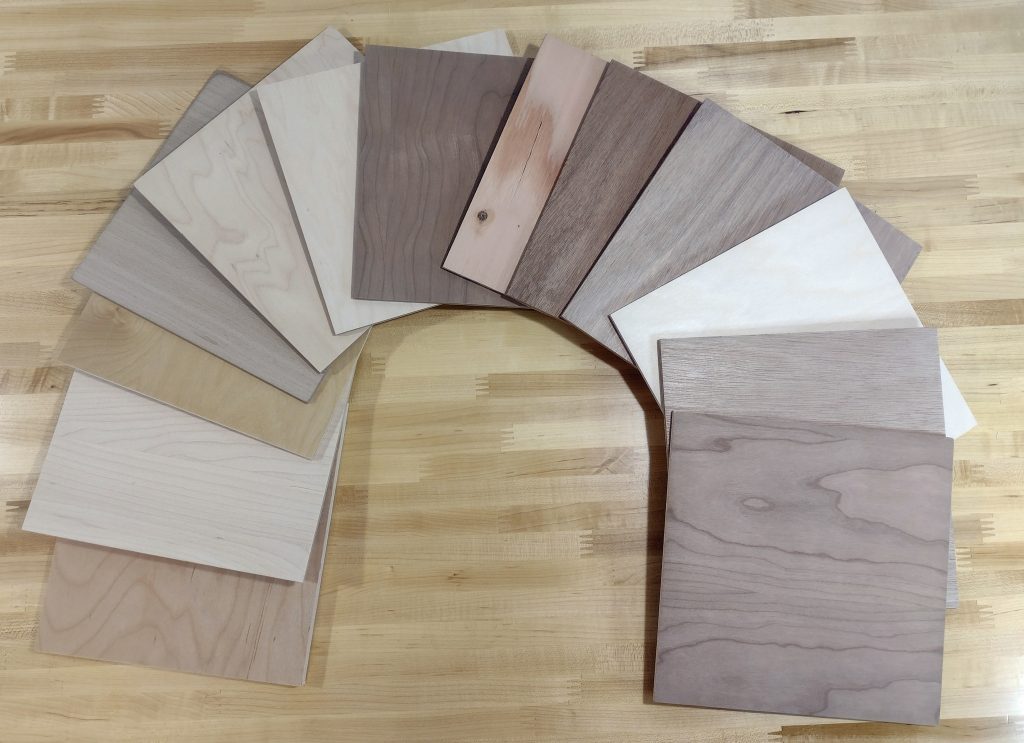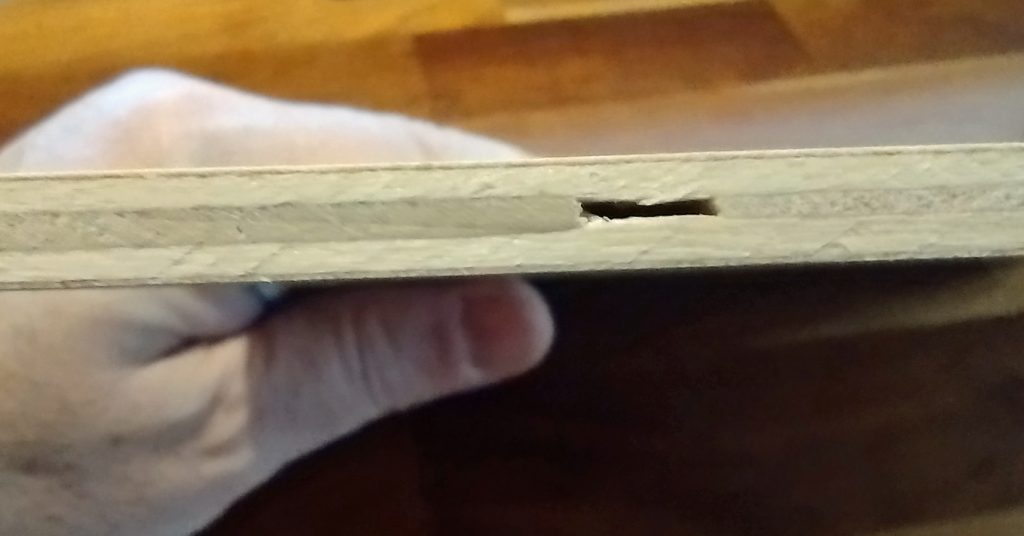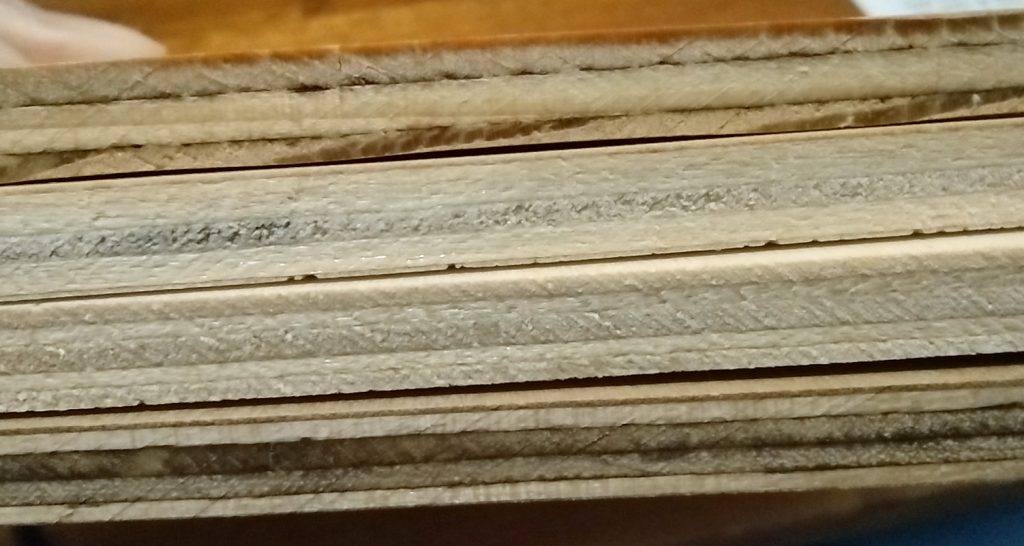There are many possible materials to use for a good jigsaw puzzle. It is not always a form of wood, either. There are numerous examples of puzzles made from materials such as acrylic, thin metal, etc. Someone has recently made a Facebook post showing they cut a puzzle out of a sheet of embossed leather. I have even heard a rumor that cardboard puzzles exist! Gasp! Perish the thought!
In general, though, some form of wood is most commonly used as a base for a good puzzle with a positive tactile feeling. I am going to examine some of the options available, but certainly not all of them. As always with my posts, these are my results based on my personal experience, preferences, and prejudices. There is no one right answer. (And, my experiences are based on materials available in the U.S., other materials may be easier to find overseas.)
In the past, I have mainly used Baltic birch plywood when I make puzzles. I have not always been happy with the results with respect to how the wood performs. Baltic birch is good in that it is stable and strong. Recently, I have started using a product called Appleply with a cherry veneer on it. This is made by States Industries in Oregon. I like it better than Baltic birch. That is one of my prejudices I mentioned. I have been a woodworker since my age was in the single digits. My favorite wood is cherry, so I am always going to lean towards anything made of cherry.
But it may not be the best wood available for making puzzles. I have acquired a number of different samples of various sheet goods that I am going to use to make puzzles out of.
Before I start, maybe a little basic background.
Solid wood
This is exactly what it says. A piece of solid wood that is thin enough to make a puzzle with. A woodworker can take a slab of some wood, say maple, rip it to thin slices using a bandsaw, glue those sliced sections together at the edges, and make a wide and thin panel of solid wood. Solid wood presents some issues for the puzzle maker.
- may be subject to warping with moisture changes
- not strong enough across the grain – puzzle pieces might break easily
- may be expensive as compared to some other material
- time consuming to make panels big enough for a puzzle
Plywood
Plywood is an engineered material made from thin sheets of solid wood. The sheet thickness varies based on the intended use of the plywood. The thin sheets (called veneers or plies) are alternated by 90 degrees and stacked together with glue until the desired overall thickness is achieved. This eliminates the first two bullets above for solid wood. The inner layers of veneer are usually made from an inexpensive wood source. The outer layers (face veneers) are often made from a wood source valued for its appearance. Using thin veneers of expensive wood for the face veneers offsets the third bullet point above for solid wood.
Plywood can be broken down into so many different categories that it could fill a book to write about them all. The two most basic categories are construction grade and cabinet grade (or furniture grade). Construction grade plywood is made from softwood, often has thicker layers of veneer, and is full of knots and filled or unfilled voids. The 1/4″ thick stuff has 3 layers with no face veneer to it. It is ugly. Not what we want to use for a puzzle, but is actually what I started with when I first made puzzles for my grandmother.
Cabinet grade plywood is made from thinner layers of hardwood veneer. The inner layers are often made from rotary cut birch, poplar or aspen. The face veneer is often made from plain sliced hardwoods such as cherry, oak, walnut, etc.
This on-line article from Wood magazine explains the difference between rotary cut and plain sliced. What veneer patterns are available for plywood? | Wood (woodmagazine.com)
This is an interesting video on cutting rotary veneer in a modern plywood factory. Plywood Machinery | Veneer Rotary Line – YouTube
This one is from a more man-power intensive time. Manufacturing plywood boards
Cabinet grade plywood will have at least one very nice surface to it. The opposite surface may be of a lower appearance quality. The interior plies may have voids in them. Most lumber stores are going to have some inventory of cabinet grade plywood in stock. Here is an image of a piece of 1/4″ maple plywood showing a void. You can see it has three inner layers with two very thin layers of face veneer. The inner layers are probably birch, and the outer layers are maple. DO NOT sand too vigorously, or you will not have a face veneer left to look at.
That void is not something you want to discover while cutting a delicate puzzle piece. You can, of course, fill it with an appropriate filler material, but that is extra work you really do not want to need to do. That brings us to the good stuff!
Multi-ply
Multi-ply encompasses a short list of very high-quality plywood products: Baltic Birch, Finnish Birch, Russian Birch, Europly, and Appleply. There may be others. Baltic Birch is usually fairly easy to find locally, the others not so much. These products have much thinner veneer layers and are supposedly void free. (I will state that I have had to discard several pieces of Baltic Birch that DID have voids in it. It wasn’t just one or two. It was like working with Swiss cheese.) These are more expensive than the cabinet grade plywoods, but for puzzle making are worth the extra cost. Here is an image showing construction grade, cabinet grade, Baltic Birch, and Appleply for comparison.
The top piece is construction grade plywood, made of three plies of a softwood such as Douglass Fir. Next, is the same piece of cabinet grade plywood we saw previously, showing three layers of an inexpensive hardwood such as birch or poplar, with two very thin layers of maple as the outer veneers. The third item is Baltic Birch. It has five equally thick layers of birch. The bottom piece is Appleply, which has four inner layers of birch and two thinner outer layers of cherry (bottom layer is hard to see here).
Fiberboards
Here is where another one of my prejudices will be evident. I do not like fiberboard (fuzz wood, particle board, etc.) in most circumstances. It is heavier than real wood, it creates nasty dust, it does not do well with moisture, does not hold fasteners well, and typically is not as strong as the equivalent sized plywood.
However, it does have some advantages. If you have ever painted a piece of wood, you realize that the wood grain shows through the paint. Some of the fiberboard sheet goods are perfect if you want to paint your product. Additionally, many of the fiberboard materials are perfectly smooth and flat and remain so as long as properly supported.
There are a lot of varieties of fiberboard available. Some are purely for construction projects and would be totally inappropriate for a puzzle. One example would be OSB (Oriented Strand Board). Another would be particle board. I think particle board in a 1/4″ thickness would just essentially crumble if cut into puzzle pieces.
Medium Density Fiberboard (MDF) – This is made from very fine pieces of wood fiber that are mixed with a resin and formed into sheets under intense pressure. There are no voids, and it is almost perfectly flat. Very easy to paint with no wood grain showing through. I have not used this for a puzzle, but others do. I do not have a piece of this and am not going to go buy a 4′ x 8′ sheet just to make a small 8″ x 8″ test puzzle.
Medium Density Overlay (MDO) – This material has great potential in my eyes. It has a wooden veneer core like the plywoods above, but the outer face layers are made of MDF. This gives the strength and resilience of plywood, with the paintability of MDF. A lot of outdoor signage is made from this material. Unfortunately, I have not been able to lay my hands on a sample.
Melamine – this has a particle board core but has face veneers made of a plastic resin like material. I would avoid this. Particle board is not particularly strong, and the plastic resin face veneers chip very easily and eat circular saw blades like crazy. I cannot image scroll saw blades doing well with this.
Hardboard (Masonite) – This is also made from fine pieces of wood fiber mixed with resin. Unlike most fiberboard, it is somewhat flexible when still in the large sheet size. This is what pegboard is made of but is available in solid sheets without all the holes in it. It comes in 1/8″ and 1/4″ thicknesses. I used to have some for making patterns that I wanted to repeat, such as for tracing out Queen Anne furniture legs to cut on the band saw. If I can find a piece in my scrap pile, I will add it to the sample list. It can be brittle, so maybe not a good puzzle material. Might be a good choice for painting pieces, though. Some of the laser cut puzzles I have acquired seem to be made with this material or something very similar.
MDF core – This is a product that has a core of MDF but is covered with face veneer of wood. I have some of this in maple and alder. I have never used it for a puzzle, but I will cut a test puzzle from it.
This link leads to a good summary of all the above and more. Woodcraft Magazine
Well, this is a long post. I think I am going to be into another three-part post series here. My next one will be details about the samples I am going to cut, and then the third one will be about the discoveries made while cutting them.
Happy Puzzling!
Bob



